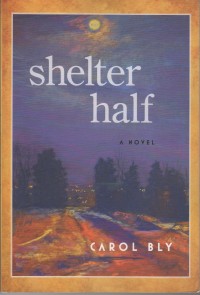shelter half by Carol Bly (2008. Holy Cow Press. ISBN 978-0977945-86-3)
Obtuse adj. 1. not quick or alert in perception, feeling, or intellect…dull 2. not sharp, acute, or pointed
Diffuse adj. 6. characteristic by great length or discursiveness in speech or writing; wordy. 7. widely spread or scattered; dispersed.
My court reporter, Renata Skube, passed along Carol Bly’s posthumously published novel, shelter half, because we share a love of good writing. Her comment to me was, as I recall, something akin to “This one’s pretty good, you’ll like it.” She’s not often wrong about my tastes in fiction. This time she was.
Where to start. St. Fursey is the setting for this imagined tale from one of Minnesota’s most beloved literary figures. We’re led to believe that this little burgh (full of Episcopalians, no less, of which there are very few in northeastern Minnesota) exists somewhere near the Mesabi Iron Range along Highway 53. Or not. I say “or not” because if that’s the setting, Bly doesn’t describe it or use it very well as the backdrop for the story she is seeking to tell. Having lived my entire life in the region, and having been accused (and applauded) by various reviewers of inserting my backyard as a character in my fiction, I don’t feel the same connection to the land from Bly as I do, for example, when reading Jon Hassler or Herbert Krause.
Then there is the dialogue: Ms. Bly studied and taught creative writing, including short fiction, for all of her adult life. She spent segments of her childhood and adulthood in northeastern Minnesota (she was born in Duluth in 1930 and returned to live in the region in the late 1980s). If the reader of shelter half accepts that biographical data as true, the question to be raised is: Why doesn’t Bly reflect the region’s speech patterns and dialect in her writing? I’m not talking about some, Fargoesque paraody of how we northeastern Minnesotans sound. There’s no need for a writer to make his or her characters out to be woodsy idiots who can’t speak understandable English. But the passages of dialogue in this book don’t even hint at, much less portray, how folks like me carry on a conversation.
Lack of setting detail and unfamiliar dialogue aren’t my primary beefs with this book. The poorly constructed, often disappearing plot threads are the real culprits here. Bly opens the story with the discovery of a murdered (and likely raped) young woman. The victim remains nameless and faceless throughout the story. There’s a hint, and only a hint, of the infamous Katie Poirier murder, which took place in 1999 in Moose Lake, MN, territory that Ms. Bly would have been well familiar with (she lived in nearby Sturgeon Lake during the same time frame). But after the discovery of the girl’s body, Bly’s novel juts off onto divergent paths, including one involving a character quitting a mysterious company in the Twin Cities. The author also explores the dynamics of several marriages in St. Fursey but those dalliances with plot never merge into a cogent or united theme. Characters appear on stage, we learn quite a bit about them, and then, inexplicably, they disappear, never to be heard from or seen again. I think I am a sophisticated enough writer and reader to understand that not every work of fiction needs finality or completion. Indeed, the ending of my own novel, Pigs is in this vein, asking more questions in the final chapter than it answers. But this tale is so topsy-turvy , so disjointed, that, in the end, there’s really nothing revelatory or concrete to take away from its 243 pages.
Perhaps the reason the book seems so incomplete is that, well, maybe it was. Carol Bly died in 2007, before this book was published. How much input did the author have into its final format, into the final editing? I don’t know but like many posthumously published works (I’m thinking of True at First Light, released decades after Hemingway’s death), this book simply doesn’t measure up to the reputation of its author.
There are a couple of well crafted scenes amongst the chaos. There’s a scene involving an abusive husband who believes that he’s able to handle just about any job if only someone would give him a chance. He pulls up his trousers and asks the local car jockey for a job, a simple, easy position at the bottom of the ladder, only to have the day end in disaster. Other than that scene, painted with completeness and believability by the author, there’s little else to this book to honor Ms. Bly’s lengthy career as a storyteller.
2 and 1/2 stars out of 5.



